Why Authenticity Wins Today
AI is everywhere – including product photography. That’s fine. But in a world of flawless, polished, almost identical images, outdoor product photography stands out.
I’ve seen this many times while working on brand shoots: the moment we step outside the studio, the product immediately feels more alive. Natural light and real-life context add layers that no amount of retouching can replicate. This aesthetic feels like a breath of fresh air – imperfect, human, authentic.
And the data backs it up. 86% of consumers say authenticity is a key factor when deciding which brands to support (From Day One, 2025). Even more striking: authentic images increase consumer trust 2.4 times compared to stock photography (Sproutworth, 2024).
These numbers — and these experiences — prove one thing: authenticity is a business driver. From my perspective, it’s also the simplest way to create an emotional bridge between a product and its audience. The real question is: how can a brand achieve it through photography?
Natural Light as a Shortcut to Authenticity
One of the most powerful ways to communicate authenticity is through natural light. Unlike studio lighting, which often feels controlled and predictable, natural light introduces imperfection — shadows, reflections, warm tones — that make an image feel alive.
When I shoot outdoors, in real spaces, the product instantly gains context. Outdoor product photography turns a perfume bottle in the forest into more than just glass and liquid; it becomes part of a sensory story. This “lived-in” aesthetic signals to consumers that the brand values honesty, uniqueness, and connection over sterile perfection.
Authenticity Converts: The Business Case for Natural Light
Natural light isn’t only an aesthetic choice — it shapes consumer behavior. People perceive naturally lit imagery as more trustworthy and relatable. In e-commerce, that trust translates into longer time on page, higher engagement, and stronger conversion. Replacing studio-perfect packshots with photos taken in real environments helps a brand move from “advertisement” to “recommendation.”
The effect is measurable. A retail study showed that areas lit by daylight generated up to 40% higher sales than artificially lit ones (Eneref, Daylight in Retail). Other research finds that consumers prefer and better remember images set in nature over sterile studio shots. Authenticity, then, is not just creative polish — it’s a proven business advantage.
Turning Light into Trust
Authenticity is one of the most powerful factors driving consumer decisions today — and research makes that clear. From my own experience, I’ve seen how natural light can bring out that authenticity while giving every product a unique character, complete with its imperfections and quirks. In a world saturated with polished, artificial visuals, authenticity is what sets a brand apart and creates lasting connections with its audience.

